|
Son of Frankenstein
(1939)
Son of Frankenstein, the third entry in Universal's
Frankenstein series, finally establishes the Monster, the only remaining
character from Bride of Frankenstein, as focus of the series.
Synopsis:
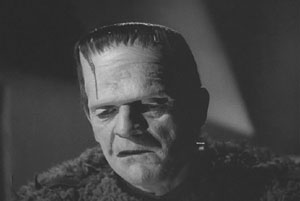
Boris Karloff as the Monster |
Baron
Wolf von Frankenstein, son of Henry Frankenstein, returns to his home
village to inherit his father's castle. From the moment of arrival on he
senses that he is not welcome. The villagers have not forgotten the
crimes of
Frankenstein's creation. They even believe that the Monster is still alive
haunting the woods and killing innocent people. When Wolf visits his
father's destroyed laboratory he runs into broken-necked Ygor, a body
thief, who was hanged for his crimes but miraculously survived. He leads
Frankenstein to a secret chamber in the laboratory, where he shows him the
Monster. He is still alive but in a coma because he was struck by
lightning.
Frankenstein desperately wants to clear his family's
name, so he is easily convinced by Ygor to heal the Monster, which he believes is immortal. After an examination Frankenstein finds
out that the Monster is indeed a kind of
super-human with incredible strength and super-power.
|
Frankenstein rebuilds his father's laboratory and
eventually reanimates the Monster with
electrical power. Soon after the resurrection Ygor's true motives for
befriending the Monster are revealed. He uses the Monster, who obeys only
him, to kill those people who sentenced him to death many years ago.
After
three more murders are committed by the Monster, one of the victims being Frankenstein's
servant Benson, Wolf finds out the truth and shoots Ygor. When the Monster
discovers his dead friend he destroys the laboratory and kidnaps
Frankenstein's son. Police inspector Krogh and Frankenstein confront the
Monster in the laboratory and Frankenstein, swinging on a chain, pushes the creature into a fiery sulphur pit.
|
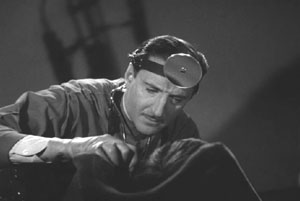
Wolf von Frankenstein (Basil Rathbone)
at work
|
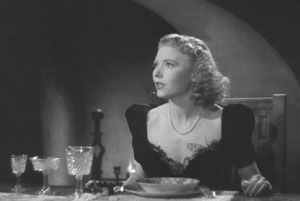
Elsa von Frankenstein (Josephine
Hutchinson) |
Originally intended to be filmed in colour, Son
of Frankenstein, directed by Rowland Lee, was filmed in black and
white after it had turned out that
Boris Karloff's mask did not photograph well in
colour. A wise choice, since the black and white photography and the bizarre sets
(especially the huge castle with references to Robert WIene's 1920 classic
o German expressionism Das Kabinett
des Dr. Caligari) create an almost dreamy, unworldly mood and eerie
atmosphere, which suits the film much better than colour photography.
|
|
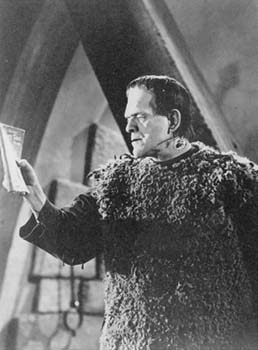
Not
really a literate monster:
Boris Karloff in Son of Frankenstein
|
Like its predecessor Bride of
Frankenstein, Son of
Frankenstein marks another change concerning the Monster's character. In Bride of Frankenstein the Monster had
been further humanized by giving the character emotions, feelings and the ability to speak.
Yet in Son
of Frankenstein most of these developments are again reversed in order to
dehumanise the Monster. On psychological, intellectual and emotional levels the
creature has been degraded. The Monster is again mute, brutal and unintelligent,
all of which enables Ygor to misuse him for his own crimes. Although there are a few
scenes where the Monster shows emotion (e.g. his agonised scream when he
discovers that Ygor is dead; his revulsion when he sees his mirror image -
similar to a scene in the novel and in Bride of Frankenstein where he sees his face in a lake), he is
nothing more than a dumb killing machine under Ygor's command.
There is another such instance of misleading humanity in the Monster: After the kidnapping of Wolf's son Peter, the Monster hesitates to
throw the child into a fiery pit, a scene reminiscent of that with the
little girl in Whale's first Frankenstein film. At this point the viewer might well assume
that the Monster has kept some of its human characteristics.
However, in the final fight the Monster throws the boy
to the floor and brutally sets his heavy foot on him in order to keep him from
fleeing. Driven by revenge, the Monster has come to a point where he would
even hurt a child. At the end of the film the Monster is far more inhuman
than it
was in the 1931 film.
On
a physical level this dehumanisation is continued by making the Monster a
kind of superhuman. Ygor stresses that Frankenstein gave his creation eternal life,
which is confirmed by Wolf, who discovers two bullets sticking in the
Monster's heart. He has a heartbeat of 250 bpm, unknown cell structure and
incredible strength making him nearly invincible.
|
Like Frankenstein's creation, the broken-necked Ygor, a kind of
monster himself, is a society outcast due of his crimes and his ugliness.
Officially declared dead after being hanged, Ygor now haunts Frankenstein
castle and is feared by children. To the villagers he has become a kind of
ghost when he miraculously escaped the grip of death.
To Wolf Frankenstein Ygor is like a Faustian Mephistopheles. He
leads him to the Monster and convinces him to continue his father's
experiments and to bring the creature back to life. But unlike Pretorius
in Bride of Frankenstein, Ygor is not interested in science; his only goal is to finish his bloody
revenge on the villagers. This makes Ygor the true evil
character in Son of Frankenstein.
|
Like the Monster, Wolf von Frankenstein, the son of the original
Frankenstein, becomes a puppet in Ygor's game of revenge. Wolf possesses his father's spirit, the wish to explore unknown regions of science. But until he
meets his Mephistopheles Ygor, he would not dare to continue his father's
experiments. So Ygor uses all kinds of powers of persuasion to promt him
to
continue the experiments. The key moment is that where Ygor suggests that
somehow Wolf and the Monster are half-brothers. Since Wolf's father Henry Frankenstein
created the Monster this practically makes him his father. The only difference between the two
is that the Monster's "mother" is lightning. And indeed, they are like Cain
and Abel, one a failure, the other resembling the father.
Yet, the true driving force for Wolf is not brotherly love. In one scene
he madly changes an inscription on his father's coffin from "Maker of
monsters" to "Maker of men". Wolf wants to find a
justification for his father's deeds in order to clear the name
Frankenstein although he knows that for ethic reasons he would have to
destroy the murderous creature. |
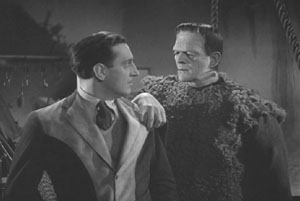
Brothers...
|
A rather interesting point in Son
of Frankenstein is the constant discussion of the confusion of the
name "Frankenstein" with the (nameless) Monster. In the very
first scene Wolf von Frankenstein complains to his wife that people now
only think of horror when they hear his father's name and that at least 9
out of 10 people call the Monster Frankenstein. And indeed, the people in
the village are afraid when they hear the name Frankenstein. Furthermore,
police inspector Krogh tells Wolf that the villagers actually name the
Monster Frankenstein. The name has become a symbol of evil.
In reality this obvious confusion, the fading of the dividing line
between the creature and its creator, was reinforced by the fact that all
subsequent films had the name Frankenstein in their title, although the
character of Henry/Victor Frankenstein only appeared in the first two
films. Instead of Frankenstein the Monster is the central figure and
linking element in all these films. In subsequent Universal films the
character was not further developed but stayed more or less the same
killing machine it had become in Son of Frankenstein.
After Son of Frankenstein
Boris Karloff never played the Monster again because he thought that the
possibilities were exhausted for both Dr. Frankenstein and his creation.
Karloff, for many movie
fans the one and only Frankenstein Monster, stated, "I
owe him so much that I owe him a little respect, a little rest."
Years later Karloff recalled:
"There
was not much left in the Monster to be developed, we had reached his
limits. I saw that from here on, he would become rather an oafish prop, so
to speak, in the last act or something like that, without any great
stature." (quoted from Jones 1995) 1
However, Boris Karloff returned
to the Frankenstein franchise two more times, not to play the creature but in the role of the
creator: In 1944 he was the scientist Nieman in Universal's
House of
Frankenstein and in 1958's
Frankenstein 1970 Karloff was a 20th century descendent of Victor Frankenstein.

|
Cast & Crew: |
|
| |
|
|
Wolf von
Frankenstein |
Basil Rathbone |
| Ygor |
Bela Lugosi |
| Inspector Krogh |
Lionel Atwill |
| The Monster |
Boris Karloff |
| Elsa |
Josephine Hutchinson |
| |
|
| |
|
| Make-up |
Jack Pierce |
|
Screenplay |
Wyllis Cooper |
|
Music |
Frank Skinner |
|
Cinematography |
George Robinson |
| Producer |
Rowland V. Lee |
| Director |
Rowland V. Lee |
Footnotes: 1 Jones, Stephen. The Frankenstein Scrapbook: The Complete Movie Guide to the World's Most Famous Monster.
(New York: Carol Publishing Group, 1995) 12


|


